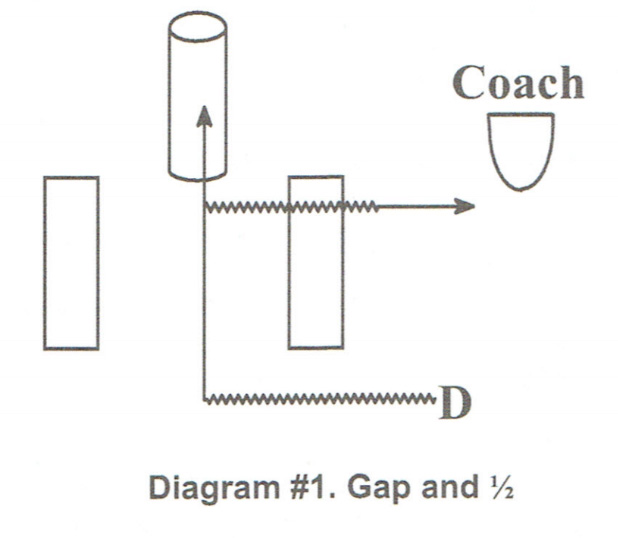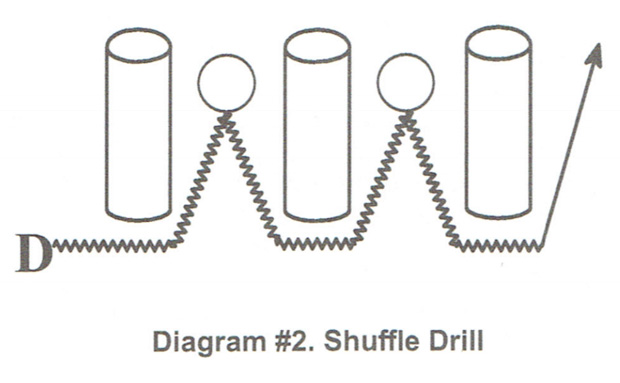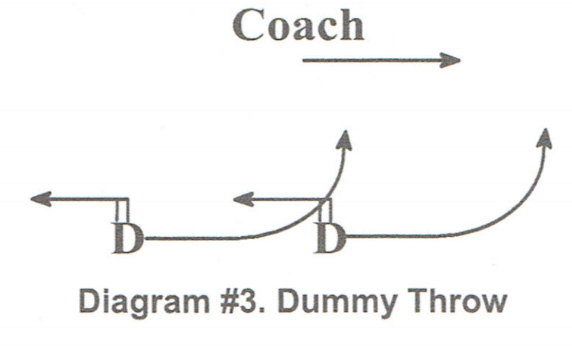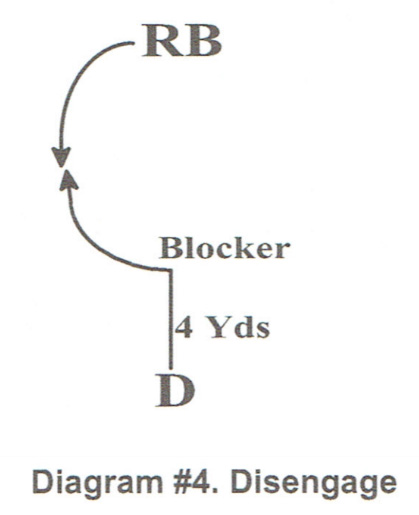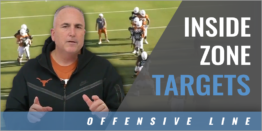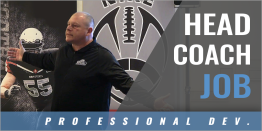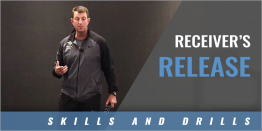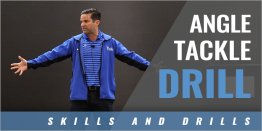| Stop the Run First |
| By: Don Brown - Univ. of MI
Originally Published in: Nike 2017 Coach of the Year Clinics - by Earl Browning Provided by: Nike Coach of the Year However, before you do anything defensively you have to stop the run. I have some principles that are really important. I think whatever system you run these principles can be applied to whatever you do. I will talk about a combination of individual techniques and a combination of run concepts. The key thing is I think I have enough things to talk about that you will get something out of it. I feel good about what I am going to talk about. One of the best player's I ever coached showed up today with his son. I told him a hundred years ago, that the most important thing he would ever do as a man was to be a father. Let us get to it and talk some ball. Does anyone know anything about the systematic approach at the University of Michigan? You can solve your problems with aggression. We are not going to work our way through schemes and things like that. We are going to come at you and try to suffocate you. I am going to get my hands on the offense player with great technique and rush the quarterback. That is what we are going to do and that is our approach. This year at Michigan, we lead the Big Ten in 17 of the 26 defensive categories. We were number one in the nation in total defense. We were number one in pass defense. Number one in opponent's completion percentage. We were number one by six percent. The number one defensive category is scoring defense. Do not let them score or at least minimize the damage. Field goals are not all bad. If you want to play great red zone defense, do not let them into the red zone. That is how you deal with that. Next is total defense. We want to make it tough. We are good on defense because of the "TFL's" (tackle for loss) and sacks. In 2016, we had a 121 tackles for loss. That is a lot. We had 46 sacks. That is a lot of sacks. All those things add up to negative plays and help you get off the field on third down. We are trying to create a third and long situation. That is what we are trying to get done. When it comes to turnovers we were in the middle of the pack. We were 67th in turnover margin. We were 44th in interceptions and we were 95th in fumble recoveries. That is not good enough. That is the area we need work on so we can continue to help ourselves. In the red zone, we were 3" in the country in red zone defense. I think we have a good red zone package, but the best way to play red zone defense is not to let the offense get into the red zone. This gives you an idea of the things and categories that I think are important. Let me branch off and talk a little about philosophy. • When one door closes another opens. But often we look so long at the closed door we do not see the one that is open. • There are great things to come. See life, live life, and do life. • Opportunity is nowhere. Opportunity is now here. There are two ways to look at that. You look at one statement as a positive and one as a negative. I ask that question every year. When we get in the first meeting I ask that question to the freshmen. All the older players in the back are chuckling and saying, They ain't getting it right." That is the age and society that we now live in. Everybody wants to poke a hole in the pinata. When I came to Michigan, I was the third defensive coordinator they had in three years. This time it is going to be a long time, a very long time. But I think it is the one that describes everything you do. Every morning in Africa, the Gazelle wakes up knowing that today he has to run faster than the fastest lion or be killed. Every morning the lion wakes knowing that if he does not run down the slowest Gazelle, he will starve to death. It does not matter whether you are a Gazelle or a lion, when the sun comes up you better be running. Great players possess great attitudes. Be ready to play fast and never, ever flinch. That is the mindset we want to create on the defense. I want to let the people that are playing defense know that we are drawing a line in the sand and we are attacking all offenses. Attack, attack, and attack, is what defense is all about. When my players are done playing football that is the way I want them to attack their lives. Get after it because it is a challenge every day. You either get better or you get worst. You are not going to stay the same. You go up or down. 'A position with strong relationships is an invincible position. Relationships are all there is." - Son Tzu That is a great quote made by a great philosopher. I coached at Yale for the legendary coach Carmen Cozzi. I was ripping my defensive players one day, when he walked past my drill. He told me if I wanted them to pursue the football tell them you love them. You must work on relationships with them. You have to show them you love them and get them to play hard. I did not say make it easy or accept mediocracy, I said let us get it done. • A key to describing your personal brand identity is to imagine a good friend introducing you to an audience using a descriptive middle name. That middle name should describe your major interest, area of expertise or identity. I had a good player, but if I used Josh in referring to him, he became mean as a rattlesnake. I knew how to get him to play and I knew what turned him off. He was a great talented guy. How would you like that as a brand? • When you feel most secure you become most vulnerable to surprise. "Hey, I got this." "We are good, I know what we are doing." You are alright and think you have the world by the tail and all of a sudden someone raises up and punches you right in the kisser. Do not ever let up and make sure you are on attack mode every moment of the day. • We cannot compete as individuals against others who are functioning as a team. That is obviously self-explanatory and speaks for itself. If you have a bunch of individuals on your teams, you better figure out how to fix that. You cannot let them play for a team. • Extraordinary effort generates extraordinary results. I do not care about the talent level, you give me extraordinary effort and good things happen. • Coordinate tactics with strategy. I am a schemer. I like it. I want to make your life miserable. But if you want the schemes to work you better coach fundamentals. You have to give them a toolbox full of things they can use. You want something in that tool box they can hang their hat on. I do not talk about winning and losing. I despise the word losing. However, I am no stranger to it. We have all been there. However, I will recover and go to work the next day. We do not want to talk about losing. We want to talk about winning and success. What Leads To Failure, Every Time? • Jealousy - Must wipe out selfishness and pettiness. • A "know it all" mentality - Accept coaching and corrective criticism, critique the performance and not the performer. • Outside influences - create negative perceptions, they do not know what goes on within the program. • Off the field - Pick the team or pick yourself choices. • What directly leads to a lack of success is a culture that permeates sensitivity. MEN DO NOT BITCH we need our defense to be played by PROUD MEN. • Immaturity - when you understand that your teammates are counting on you to do the job, understanding it is not what you do IT IS WHAT YOU ARE SUPPOSED TO DO. You cannot have jealous and petty players. That gets into some crazy stuff inside the team. Things like "That's my seat." Petty and selfish and "I want mine attitude." I want them to cut it out so we can have a chance at success and that is what is really important. I can relate to the next point of "know it all" mentality. I think in coaching I have a tendency to be that way. But I always critique the performance and not the player. I do not get personal. I think that is a problem. Stay on task and coach the player. Fix his problems. People outside the program do not know what goes on within the program. This is a big problem you have as the high school coach. The recruiting of high school athletes has gotten out of hand. When you recruit players two and three years before they graduate creates a big problem for the high school coach. The players listen to people outside the program and make some bad choices. Keep the athletes humble, keep them on the right track and keep their arrow pointed up so they get better. It is a big job. Wow, that is a big deal. Get control of your room. Get them in your room, coach scheme, talk about life's lessons, and build relationships. Take them out to dinner or bring them to your house. They will never forget those types of things. Off the field, looks like an easy choice. You pick the team or you pick yourself. Make a good decision. Tell them you are out because there is trouble brewing here. If you take drugs or something else that goes against the grain of the program, you are done. Everybody know what you do that is outside the program standards. In this day and age everyone knows what you do. There is nothing on the "low-low", everybody knows it. You are the one who is going to pay the price. You only get one career. What leads to a lack of success is a culture that permeates sensitivity. Come on, this is football. It is a tough game for tough people. It really is. There is no room for sensitivity. I can guarantee you that and I have done this at all levels. We do not need players who bitch, we need our defense to be played by proud men. I do not want to hear how tough the job is. Do your job. Do what you are supposed to do. That is what Bill Belichick says. He is the most successful coach in the game right now. Success comes from a culture that values hard work, character, and respect. Think about the great players that you coached. I guarantee you will say he was the greatest player because he knew what to do all the time. I coached Jabrill Peppers this year and thank my lucky stars I got the chance to. He starred in this respect. When he came to us, he was a safety and weighed about 207 pounds. I do not know what they advertise him at but that is what he weighed. He was the defensive player of the year in the Big Ten. He was always ready to practice. He played the Viper position, which is our hybrid player, for us on defense. He returned punts and kickoffs and when he finished with that he went and practiced with the offense. He was a great player. In addition to all that he was smart as a rattlesnake. If he made a mistake, you only had to tell him once. It is funny how that happens. He knew his stuff. You as the coach have to demand that he does. • With organization comes success • With success comes confidence • With confidence comes leadership With organization comes success. What we do systematically gives our players a chance. Let us not underestimate what we are doing in here. You only get one shot to give that group a system that has something you can hang your hat on. That is a lot. The coaches are also the beginning of the chain. If our organization gives them a chance at success, then they will have the chance to be confident. That is how you develop the leaders. That is a chain of events. That really is important. Before we get into shifting gears away from my philosophical whatever, I want to talk about something else. Michigan Defense 2016 • We must stop the run! - Develop structure to stop the run and stick with it; this gives your players an opportunity to "play fast" with confidence ° You must involve all 11 players in the run game ° You must have "over-hangs." Develop trust in your front so they know where their help is ° Have a way to "spin" or "travel" versus motion to create "over-hangs" ° Be fundamental in your approach but also have tempo changes in your run defense If you do not stop the run and stand for something you are in a lot of trouble. I do not want to hear, they throw the ball. You must stop the run. There are all kinds of offenses and techniques on the offensive side of the ball. Set your way to defeat the things they do, stick to it, and play ball. The thing is not to have a plan, the thing is to get good at the plan. Here is the deal. When you play defense you must get your hands dirty. Stop the running game with all 11 players on the defense. It is an 11 player proposition defending the run in this day and age. Make sure you are defining what you want them to do. The defense must know where their help is coming from. Here's the deal. I am a defensive end. I am 6-4 and weight 270-pounds. The offense is going to run the zone read at me. 1 am playing on the open end side with a B-gap fit linebacker. I am the end closing down and I must play the quarterback on the option. Holy crap! You must have a way to get that defensive end some help. Where is the help coming from? What I am talking about in stopping the run is to do it with numbers. If I put a tape on, all I have to do is count the box and I know what the offense is going to do. With five in the box they are going to run the ball. You need six in the box to stop the run. You as the defensive coach has to find a way to get that done. Then I watched the linebackers. They are defending two gaps. I think holy crap, they are going to defend two gaps. You have to have a plan to stem or travel with motion to create an over-hang defender. I will show it to you and make sure we get into it. You have to have plans to handle everything the offense is doing. We have hard fast rules to handle those types of things. Passing Game, Make Them Earn It • No free access, Make them earn everything in the passing game ° Allows you to focus on fundamentals and techniques ° Spend time on stacks, bunches, and motion adjustments ° Have a way to pass off the mesh routes Never give a receiver access to the field. Make him beat someone to get off the line of scrimmage. Get the defense you want to play and then make sure your players are comfortable playing close to people. Which would you rather do? Would you rather the 4.3 sprinter come ripping off the ball and run right past you or would you rather get your hands on the receiver and redirect all of his routes? I am passionate about that. That is my feelings. You want to spend time covering the stack, bunch, and motion adjustments. We have our coverage deal and we have all of the adjustments from that scheme. Whatever the defense there is going to be no space. We are going to press and crowd the wide receivers. One of the things you must do is find a way to pass off the mesh route. Make sure you have everyone focused on the same page. Here is my take on that. How many days do we practice? The answer is every day. You have to work on that in practice. In the game situation, we have to win, we have to be right, and you have to be better. We are a package Team • Share the workload by involving players with specific strengths to do specific jobs; allows you to involve more players into the game plan • "Viper personnel" Allows us to show multiple looks with the same people on the field The last five players who played the viper position are now in the NFL. The viper is the player that allows you to be multiple with the same dudes on the field. Get Off the Field on 3rd Down! • 3rd down success is critical. We must get off the field as fast as we can; use all packages (4 downs, 3 downs, Exotic) to provide yourself with several options to compete during the course of a game, make sure that you have a minimum of 12 option at your disposal. We go down the line with the situation and the coverage on the play. That is my feeling on those two items. Meeting and Practice Structure: • Always start meetings together • Make sure the entire defense is on the same page, regarding how we will defend this week's opponent? • All adjustments will be shown to the entire defense, first show adjustments drawn and then show the plays you will be using, those adjustments for offense's video • All new concepts are presented on Tuesday, These new concepts will be run every day to get the necessary repetitions We want the entire defense in the meeting on Tuesday. Make sure the entire defense is on the same page as to how you are going to defend the opponent. Show all the adjustments to the entire defense. The first thing you do is draw the adjustments on the grease board. Then you follow that with the video. We are going to show them how we are going to attack those things and how we are going to align to them. If you have a new concept you want to put into the game plan, show it on Tuesday so you can practice it all week. Do not wait until Wednesday or Thursday to try to put it in. The team will not have enough repetitions on the play to be comfortable with or confident in running the scheme. Tuesday you run the new concept and get it on film. You watch the film and do the corrections on Wednesday and run the concept with the corrections. You film it again and watch the tape. If you are satisfied, you rep it again on Thursday. Friday we have a walk through and Saturday we go play. Have a Plan for the Week! • Tuesday - 1st and 2n° Down (Top 5 runs and Top 5 passes) • Wednesday - 3rd Down • Red Zone Work Every day Have a plan for the week knowing it could change. Tuesday we work the repetitions of plays we have to stop. We have their top five running plays and the top five pass patterns they throw. We work 3rd down on Wednesday, but we could alter that somewhat and run it more days if we need to. We work red zone defense every single day. Find a couple of things that you are really good at for the red zone. Work on them every day and rep them so you are better prepared in that situation with those concepts. Get Multiple Units Prepared! • We have a R.O.C.K. (Rehearsal of combat knowledge) to start every practice; rotate after 5 plays, get all units reps this rotation process continues through all periods • Split up the front 7 and the secondary; secondary works on bunches, stacks, and motion adjustments (preparation on this scenario is paramount in our thinking) • The front seven jumps on cans for gap review and adjustments we can get several reps in short period of time Relationships are everything! • Relationships between coaches and players are vital to success • The end of the day this is still about the development of young people let us make sure that we make a difference on our players lives To get multiple units prepared for practice we have a ROCK. You have to get players ready to play. In our situation it is really unique. We have a lot of older players and a lot of younger players. The coaches are getting the young player ready to take over and the older guys are getting ready for the challenge. In the rotation process, we start and we do not stop. We split the front and secondary for adjustment period. The secondary works on stacks, bunches, and motion adjustments. The front works on gaps, alignments, and pressure schemes. We use trash cans for offensive linemen. That allows us to work on our gaps, movements, and adjustments. We can get a ton of reps in a short amount of time. We are going one group right behind the other. The firsts go and then the seconds drop in. After they go the firsts go again. It is rapid and we get tons of reps. If you do not have a great relationship with the players they will not play up to their potential. If you are ripping these guys all day long, do you think they will get better? That is half of the player's mindset. With a good relationship, you can work them as hard as you want and rip them. They know you care and at the end of the day, the coaching is all about the development of young people. Make sure you make a difference in that player's life. The first drill I want to show you is called "Gap and 1/2." (Diagram #1) To set the drill up, you need two long flat bags to make a lane for the defender to attack up through. There is a bag holder at the end of the lane. The defender aligns in a linebacker stance. He shuffles to get into the lane. He comes forward and delivers a hand shiver on the dummy. To get out of the lane he steps over the dummy while keeping his shoulder square. There is a coach to the side with a hand shield that the players rips as they go by.
When I went to Boston College in 2013 as the defensive coordinator, to get a secondary coach from the University of Connecticut, I switched from coaching the secondary to coaching linebackers. I had never coached them before. I watched tape and tried to put together a practice plan of things they needed to do. In this drill you must move the feet and keep them moving throughout the drill. If you let the feet die, you lose the power. We do this drill every day. With the strike we want to keep the elbows tight to the rib cage and keep the thumbs up. When the thumbs go up the elbows automatically come inside. We want to punch with the heel of the hands. The next drill is a gap shuffle drill. (Diagram #2) We have three dummies on the ground that makes two gaps. The defensive player shuffles down the line and enters the first lane. There is a dummy holder in that lane. The defensive player delivers a punch and recoils out of the lane. He shuffles to the next lane and delivers a punch on that dummy. He retreats from the last lane and finishes the drill by sprinting by the coach.
When you work drills off of bags, we want to make sure that everyone goes right and left Do not let them move in only one direction. That is not natural for a defensive player. We want to get used to moving different feet in their movement. Everybody goes right and everybody goes left. The mistake that so many defensive players make is stepping with the power but not getting the second foot down on the ground. You have to bring both feet when you strike. When you do movement drills, it is important to have a good base. If the feet get too close together, the defender has no balance. You must keep the base wide but not too narrow when you move and strike. However, you can get too wide a base, which cuts down on your ability to move. I have a player who is going to be the next Joe Wroblewski. I tortured this kid every day and he always came back stronger and wanted more. He can be a complete tackling animal. When we get into the punch drills, some players get more concerned with finishing the drill fast instead of getting a good punch on the defender. If they do it in a game, they must remember they are playing in the Big Ten. The guards in that league are 6'-4" and 300-pounds. You must develop a punch to stay in the fight. We do a "dummy throw" drill, which helps with the disengage technique from the blocker. (Diagram #3) A defender stands in front of the coach, who is 3-4 yards away. He gives them a command to extend their arms in a lock out movement. The coach gives both linebackers a direction with his hands. He can send them both in the same direction or can make them separate.
When the coach gives them a direction. They violently throw the dummies to the ground. The throw the dummies opposite the direction they are going. This is the same type of movement that a defender would use to get off a block. When they throw the bags they do it with both hands. They exaggerate the throwing motion. When we play defense we want to play the game on their side of the line of scrimmage. We want to be gap sound, but we want penetration to their side. When the defensive lineman plays an offensive blocker, he must get his hands inside to have control of the blocker. The offensive lineman is trying to do the same thing. The defender has to get his hands inside, extend, and lock out on the offensive blocker. When he gets to that position, he can get off the block and make the tackle. We want to teach playing blocks in the open field. (Diagram #4) In this drill the defensive player approaches and engages the blocker. He wants to punch and lock out on the blocker. The running back approaches from the rear. He plants and cuts to one side or the other of the blacker. The defender has to release from the block and face up the ball carrier. This is not a live drill. The blocker has a shield dummy that the defender hits.
In the fit drills, it teaches the defenders where their help is coming from. We want the ball to run to the help or pursuit of the defense. Where the defender misses a tackle is important. We do not want to miss tackles, but if we do we want the ball to turn back to the help. We want to leverage the ball at all times. We always want to force the ball to the help. If the Mike linebacker plays an isolation block, he wants the ball to bounce to the unblocked linebacker. If that linebacker is the Will linebacker, the Mike linebacker takes the block on with his inside shoulder keeping his outside hand free. The ball carrier is forced inside and into the Will linebacker. If there is not help from the inside, he wants to spill the ball to the outside. I do not know what type of system you play. If it is quarters, cover-2, cover-1 or whatever it is. You need to make sure you have over-hang players to make your defense sound and will allow you to stop the run. Stopping the run is the single message coming out of this lecture. I want to thank you for your attention and I hope you got something out of this. COMMENTS BY JOHN MAJORS My name is John Majors, I am the President of the Nike Coach of the Year Clinics. I do not believe you will hear a better speech than you just heard. It is one of the best lectures I have ever heard. You saw it on the board in writing and in the video. This was a great clinic and I am honored to be here. Thank you for your attendance. |



